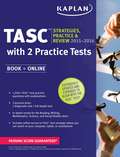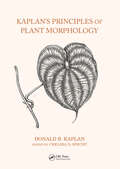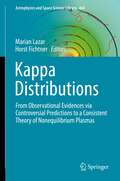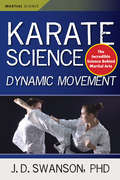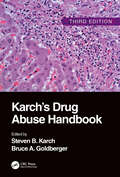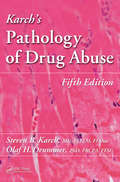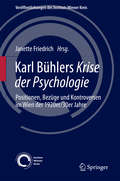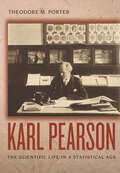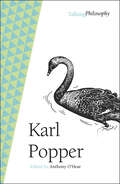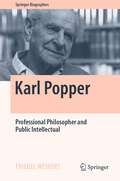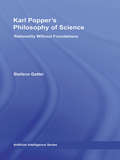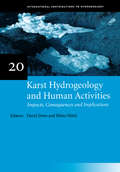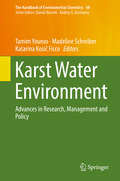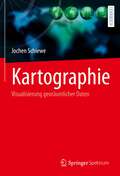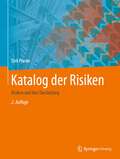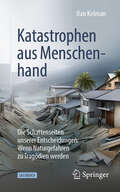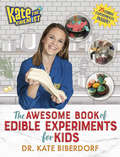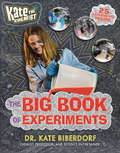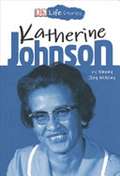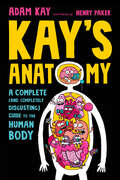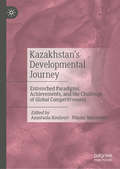- Table View
- List View
Kaplan TASC Strategies, Practice, and Review 2015-2016
by KaplanComprehensive content review, strategies, and practice for all sections of the TASC (Test Assessing Secondary Completion) from top test experts.
Kaplan's Principles of Plant Morphology
by Donald Kaplan Chelsea D. SpechtKaplan's Principles of Plant Morphology defines the field of plant morphology, providing resources, examples, and theoretical constructs that illuminate the foundations of plant morphology and clearly outline the importance of integrating a fundamental understanding of plant morphology into modern research in plant genetics, development, and physiology. As research on developmental genetics and plant evolution emerges, an understanding of plant morphology is essential to interpret developmental and morphological data. The principles of plant morphology are being brought into studies of crop development, biodiversity, and evolution during climate change, and increasingly such researchers are turning to old texts to uncover information about historic research on plant morphology. Hence, there is great need for a modern reference and textbook that highlights past studies and provides the synthesis of data necessary to drive our future research in plant morphological and developmental evolution. Key Features Numerous illustrations demonstrating the principles of plant morphology Historical context for interpretations of more recent genetic data Firmly rooted in the principles of studying plant form and function Provides evolutionary framework without relying on evolutionary interpretations for plant form Only synthetic treatment of plant morphology on the market Related Titles Les, D. H. Aquatic Dicotyledons of North America: Ecology, Life History, and Systematics (ISBN 978-1-4822-2502-0) Les, D. H. Aquatic Monotyledons of North America: Ecology, Life History, and Systematics (ISBN 978-1-1380-5493-6) Bowes, B. G. Colour Atlas of Woody Plants and Trees (ISBN 978-0-3674-7398-3) Bahadur, B. et al., eds. Asymmetry in Plants: Biology of Handedness (ISBN 978-1-1385-8794-6)
Kappa Distributions: From Observational Evidences via Controversial Predictions to a Consistent Theory of Nonequilibrium Plasmas (Astrophysics and Space Science Library #464)
by Marian Lazar Horst FichtnerThis book presents recent results on the modelling of space plasmas with Kappa distributions and their interpretation. Hot and dilute space plasmas most often do not reach thermal equilibrium, their dynamics being essentially conditioned by the kinetic effects of plasma particles, i.e., electrons, protons, and heavier ions. Deviations from thermal equilibrium shown by these plasma particles are often described by Kappa distributions. Although well-known, these distributions are still controversial in achieving a statistical characterization and a physical interpretation of non-equilibrium plasmas.The results of the Kappa modelling presented here mark a significant progress with respect to all these aspects and open perspectives to understanding the high-resolution data collected by the new generation of telescopes and spacecraft missions.The book is directed to the large community of plasma astrophysics, including graduate students and specialists from associated disciplines, given the palette of the proposed topics reaching from applications to the solar atmosphere and the solar wind, via linear and quasilinear modelling of multi-species plasmas and waves within, to the fundamental physics of nonequilibrium plasmas.
Karate Science: Dynamic Movement (Martial Science)
by J. D. SwansonDynamics, motion, and sensation are karate’s connective tissue—and they are the heart of this book. As a lifelong student of martial arts, J. D. Swanson, PhD, had searched through piles of books on form and function. Stand here, they said. Step there. But where movement was concerned, not one of them went deep enough. No one discussed dynamics—the actual feeling of the moves. Martial instruction, both in print and in person, tends to focus on stances and finishing positions. But dynamics, motion, sensation . . . they are karate’s connective tissue—and they are the heart of this book. Karate Science: Dynamic Movement will help you understand the mechanics of the human body. Swanson describes these principles in incredible detail, drawing on examples from several styles of karate, as well as aikido, taekwondo, and judo. Whatever your martial background, applying this knowledge will make your techniques better, stronger, and faster. • Understand the major types of techniques, including their outward appearances and internal feelings. • Master the core principles behind these feelings. • Learn the biomechanics and dynamics of core movement. Karate Science: Dynamic Movement is filled with examples, anecdotes, and beautiful illustrations. Although Shotokan karate is the author’s frame of reference, the principles of human mechanics translate to all martial styles. This book features • Clear and insightful explanations of dynamic movement. • Over 100 illustrations. • Profound but accessible analysis of the kihon, or fundamentals of Shotokan karate. “Karate Science: Dynamic Movement is rooted in the teachings of the masters,” Swanson says. “This book nucleates that knowledge, clarifying and distilling the key principles behind movement dynamics. This is the next evolution of karate books.”
Karch's Drug Abuse Handbook
by Steven B. Karch and Bruce A. GoldbergerKarch’s Drug Abuse Handbook, Third Edition remains the quintessential compendium addressing the pharmacological, medical, and legal aspects of drugs and informing the forensic community of the latest scientific advances and emergent practices. For this edition, Dr. Karch has brought on clinical and forensic toxicology expert Dr. Bruce Goldberger, editor-in-chief of the Journal of Analytical Toxicology and president of the American Board of Forensic Toxicology, to serve as co-editor. In addition, world-renowned scientists and medical professionals have contributed their work and expertise in tackling the latest developments in drug testing, drug-related medical emergencies, and the drug toxicology. Topics addressed include genetic testing in drug death investigation, pathology, toxicogenetics, alcohol, post-mortem toxicology, new psychoactive substances, the latest legal issues and challenges as well as drugs and drug testing in sports, and the ethical, legal, and practical issues involved. Vivid pictures and diagrams throughout illustrate the pathological effects of drugs and the chemical make-up and breakdown of abused drugs. With unparalleled detail, the latest research and the highest level of authoritative medical scientific information, The Drug Abuse Handbook, Third Edition remains the definitive resource for drug related issues.
Karch's Pathology of Drug Abuse
by Steven B. Karch MD Olaf DrummerWritten in the same accessible manner as previous editions, the fifth edition of Karch‘s Pathology of Drug Abuse is an essential guide to the pathology, toxicology, and pharmacology of commonly abused drugs. The book focuses on the investigation of drug-related deaths, practical approaches to the detection of drug abuse, and discussions of medical
Karl Bühlers Krise der Psychologie
by Janette FriedrichIm Mittelpunkt des Bandes steht Karl Bühlers 1927 veröffentlichte Schrift zur „Krise der Psychologie“. Bühler setzt sich darin mit den verschiedenen Ansätzen zur Erforschung psychologischer Phänomene auseinander. Seine Analyse der sich seit Ende des 19. Jahrhunderts als eigenständige Disziplin konstituierenden Psychologie nehmen die Autoren zum Ausgangspunkt, um die „Positionen, Bezüge und Kontroversen im Wien der 1920er/30er Jahre“ zu beleuchten. Dabei stellen sie bisher wenig beachtete theoretische Positionen Karl Bühlers vor und präsentieren neue historische Fakten zu seiner Schaffenszeit an der Wiener Universität.Die Themen der Beiträge reichen vom Neubeginn der Wiener Philosophie mit der Besetzung der drei Lehrstühle im Jahre 1922 über die Forschungen zum Film unter Leitung von Karl Bühler in den 1930er Jahren bis hin zu neuen Erkenntnissen der NS-Provenienzforschung zur Bibliothek von Karl und Charlotte Bühler. Die Verbindungen zwischen Bühlers Krisenanalyse und dem Forschungsprogramm der Brentanoschule werden aufgezeigt, sein Interesse am Medienbegriff des Psychologen Fritz Heider ebenso detailreich diskutiert wie Bühlers in den 1930er Jahren begonnenes Projekt einer Lebenspsychologie und einer Sematologie als allgemeine Zeichentheorie. Dabei beantworten die Autoren die Frage nach der Aktualität seines Denkens ganz unterschiedlich.Mit der Erschließung neuer Quellen und der Rekonstruktion historischer Kontexte sowie durch komparative Textstudien leisten die Autoren einen originellen Beitrag zur Wissenschaftsgeschichte, insbesondere zur Geschichte der Psychologie und der Philosophie wie auch zur Institutionsgeschichte der Wiener Universität am Anfang des 20. Jahrhunderts. Der Band richtet sich an Spezialisten auf diesen Gebieten, aber auch an Psychologen, Sprachwissenschaftler, Erziehungswissenschaftler und Philosophen.
Karl, Get Out of the Garden!: Carolus Linnaeus and the Naming of Everything
by Anita SanchezDo you know what a Solanum caule inermi herbaceo, foliis pinnatis incises, racemis simplicibus is?* Carolus (Karl) Linnaeus started off as a curious child who loved exploring the garden. Despite his intelligence—and his mother's scoldings—he was a poor student, preferring to be outdoors with his beloved plants and bugs. As he grew up, Karl's love of nature led him to take on a seemingly impossible task: to give a scientific name to every living thing on earth. The result was the Linnaean system—the basis for the classification system used by biologists around the world today. Backyard sciences are brought to life in beautiful color. Back matter includes more information about Linnaeus and scientific classification, a classification chart, a time line, source notes, resources for young readers, and a bibliography.*it's a tomato!A handsome introductory book on Linnaeus and his work — Booklist, starred reviewA good introduction to a man in a class by himself — Kirkus ReviewsLends significant humanity to the naturalist — Publisher's WeeklyThe biographical approach to a knotty scientific subject makes this a valuable addition to STEM and biography collections — School Library Journal
Karl Pearson: The Scientific Life in a Statistical Age
by Theodore M. PorterKarl Pearson, founder of modern statistics, came to this field by way of passionate early studies of philosophy and cultural history as well as ether physics and graphical geometry. His faith in science grew out of a deeply moral quest, reflected also in his socialism and his efforts to find a new basis for relations between men and women. This biography recounts Pearson's extraordinary intellectual adventure and sheds new light on the inner life of science. Theodore Porter's intensely personal portrait of Pearson extends from religious crisis and sexual tensions to metaphysical and even mathematical anxieties. Pearson sought to reconcile reason with enthusiasm and to achieve the impersonal perspective of science without sacrificing complex individuality. Even as he longed to experience nature directly and intimately, he identified science with renunciation and positivistic detachment. Porter finds a turning point in Pearson's career, where his humanistic interests gave way to statistical ones, in his Grammar of Science (1892), in which he attempted to establish scientific method as the moral educational basis for a refashioned culture. In this original and engaging book, a leading historian of modern science investigates the interior experience of one man's scientific life while placing it in a rich tapestry of social, political, and intellectual movements.
Karl Popper (Talking Philosophy)
by Anthony O’HearSir Karl Popper was a major thinker of the twentieth century, one who – as Anthony O'Hear writes in his new Foreword – 'has had a beneficent influence on those who have come under the spell of his thought and of the inimitable prose in which he articulates it'. It is now twenty-five years since Popper died, and thus seems – after a quarter of a century – an apposite moment to revaluate his impact, significance, and influence. The several chapters in this classic volume focus on many key elements of Popper's thought and philosophy. They are by no means uncritical, but afford Popper the respect due to a philosopher who wrote always with a degree of clarity, precision, and directness rare in the academic world of his time, and – as O'Hear puts it – 'even rarer subsequently'. This important book constitutes an essential introduction to some of the most esteemed philosophical writing of our times.
Karl Popper: Professional Philosopher and Public Intellectual (Springer Biographies)
by Friedel WeinertKarl R. Popper is widely regarded as one of the most influential 20th century philosophers. In this new biography, Weinert provides a comprehensive and accessible account of his life and work, also addressing Popper’s role as a public intellectual. Drawing on a wide range of sources and interviews with former colleagues and collaborators, he recounts not only the wide interest from the scientific community, but also the inspiration that politicians took from Popper’s work. The book surveys the vast and varied intellectual landscape of Popper's philosophical journey during his long career: from the natural and social sciences (physics, evolution, sociology) to political philosophy and the philosophy of mind. It pays significant attention to Popper’s critical method - i.e., the notion that ideas and institutions should be exposed to rigorous tests – the approach that led him to a fervent defence of objectivity, rationality and realism, against all forms of irrationalism, as well as a passionate advocacy of freedom, social justice and liberal democracy, against all forms of authoritarianism. The book brings Popper into focus as a modern Enlightenment philosopher.
Karl Popper's Philosophy of Science: Rationality without Foundations (Routledge Studies in the Philosophy of Science)
by Stefano GatteiThis book seeks to rectify misrepresentations of Popperian thought with a historical approach to Popper’s philosophy, an approach which applies his own mature view, that we gain knowledge through conjectures and refutations, to his own development, by portraying him in his intellectual growth as just such a series. Gattei seeks to reconstruct the logic of Popper’s development, in order to show how one problem and its tentative solution led to a new problem.
Karl Popper's Science and Philosophy
by Zuzana Parusniková David MerrittOf all philosophers of the 20th century, few built more bridges between academic disciplines than Karl Popper. He contributed to a wide variety of fields in addition to the epistemology and the theory of scientific method for which he is best known. This book illustrates and evaluates the impact, both substantive and methodological, that Popper has had in the natural and mathematical sciences. The topics selected include quantum mechanics, evolutionary biology, cosmology, mathematical logic, statistics, and cognitive science. The approach is multidisciplinary, opening a dialogue across scientific disciplines and between scientists and philosophers.
Karriereführer für Naturwissenschaftlerinnen: Erfolgreich im Berufsleben
by Philipp Gramlich Andrea Hauk Karin BodewitsIn Deutschland schlie?en inzwischen ebenso viele Frauen wie Manner ein naturwissenschaftliches Studium ab. Welche Karrieremoglichkeiten stehen ihnen offen? Wie begegnen sie der sehr realen Gefahr der Altersarmut durch Stipendien und befristete Anstellung? Und wie schaffen sie es, Familie und Beruf miteinander zu vereinbaren? Karin Bodewits, Andrea Hauk und Philipp Gramlich zeigen in diesem etwas anderen Karrierefuhrer, wie Naturwissenschaftlerinnen die Widrigkeiten des Berufseinstiegs meistern und schon wahrend des Studiums die Weichen richtig stellen konnen, um im Berufsleben zu bestehen. Die Autoren schopfen dabei nicht nur aus ihren personlichen Erfahrungen mit der Arbeitswelt, sondern lassen zahlreiche Wissenschaftlerinnen zu Wort kommen, die ihre mehr oder weniger geradlinigen Karrierewege schildern. Frauen aber auch Manner finden hier viele wertvolle Karrieretipps, von Alternativen zur klassischen Forscherkarriere uber die richtige Bewerbung, Aufstiegsmoglichkeiten und beruflichen Wechsel bis zum Wiedereinstieg nach einer Familienpause. Sein lockerer und humorvoller Stil macht das Buch zu einem sympathischen Begleiter durch das Berufsleben, den man beziehungsweise frau nicht mehr missen mochte!
Karst Hydrogeology and Human Activities: IAH International Contributions to Hydrogeology 20 (IAH - International Contributions to Hydrogeology #20)
by David Drew Heinz HötzlOne quarter of the world's population lives in karst terrains, yet karsts are highly vulnerable to stresses caused by human activity. This book surveys human impact on karst water, showing that the increasing pollution of the environment has, to a great extent, spoiled sensitive karst ecosystems. This text examines such consequences and offers proposals for future solutions and strategies. Part One provides an overview of the functioning of karsts and of human interaction with karst environments over several millennia. Part Two consists of a systematic examination of the major areas of human activity affecting karst waters, such as agriculture, industry, mining and water exploitation. Finally, Part Three views the effects on karst groundwater within a broader societal and legislative perspective and considers possible changes of methodology and approach.
Karst Water Environment: Advances In Research, Management And Policy (The Handbook of Environmental Chemistry #68)
by Katarina Kosič Ficco Madeline Schreiber Tamim YounosKarst aquifers are important sources of drinking water worldwide. This volume presents a discussion of the current state of knowledge on karst science, advances in karst mapping and karst aquifer monitoring technologies, case studies of karst aquifer assessment, and regulatory perspectives on land use and water management in karst environments. It offers valuable reference material for researchers involved in karst science and environmental studies, as well as a guide for experts at governmental agencies, scientists, engineers and other professionals involved in karst aquifer protection and the design of land and water management systems in karst areas around the globe.
Kartographie: Visualisierung georäumlicher Daten
by Jochen SchieweWie würde unser Leben aussehen, wenn es keine (guten) Karten gäbe?Karten helfen dem Menschen, sich besser und schneller zu orientieren, zu navigieren sowie die komplexe Umwelt auf das Wesentliche zu reduzieren und schließlich besser zu verstehen. Die Visualisierung von georäumlichen Daten unterstützt Laien und Experten bei ihren alltäglichen Aufgaben im privaten, beruflichen oder wissenschaftlichen Bereich. Es werden immer mehr Karten erstellt, dank des Internets immer schneller verbreitet und auf unterschiedlichen Endgeräten wie Smartphones oder Tablets auch im Alltag genutzt. Der Trend zu immer mehr Karten bedeutet allerdings nicht, dass auch immer mehr „gute“ Karten erstellt werden – also solchen Karten, die ihren Zweck tatsächlich effizient erfüllen.Das Buch deckt die ganze spannende Breite des Faches Kartographie ab: Zum einen wird der Kern der Disziplin behandelt, der sich mit der graphischen Kodierung von georäumlichen Objekten und Eigenschaften sowie dem Raumbezug bzw. den Kartenabbildungen beschäftigt. Zum anderen werden wichtige Randbereiche für das „Rundum-Verständnis“ behandelt – z. B. die Überprüfung der Gebrauchstauglichkeit von Karten, die Erfassung und Verarbeitung der zugrundeliegenden Geodaten oder das Kartenrecht. Statt technischer oder Software-abhängiger Beschreibungen legt der Autor den Fokus auf die Vermittlung von Konzepten und Methoden der modernen Kartographie. Hierzu tragen einführende Überblicke zu den Kapiteln, zahlreiche Abbildungen sowie viele Übungsaufgaben bei.Ein wichtiges Lehrbuch, das Studierenden und Lehrenden aus vielen Disziplinen (Kartographie, Geographie oder Geodäsie, Stadt- und Regionalplanung oder Umweltwissenschaften u. v. a.) bei der Gestaltung und Nutzung solcher „guter Karten“ hilft. Auch andere, einfach „nur“ kartenbegeisterte Menschen werden von den hier beschriebenen Grundlagen der modernen Kartographie profitieren.
Katalog der Risiken: Risiken und ihre Darstellung
by Dirk ProskeDie Risikolehre bewertet basierend auf empirischen Daten die potenziell negativen Konsequenzen von Entwicklungen und Handlungen. Sie stellt einen wichtigen Bestandteil der Entscheidungstheorie dar. Neben der Quantifizierung der negativen Konsequenzen gibt die Risikolehre auch die Unsicherheit der Bewertung an. Das Buch beginnt deshalb mit der Diskussion der Begriffe Unbestimmtheit, Komplexität, Katastrophe, Sicherheit und Risiko. Im zweiten Kapitel werden Risiken in natürliche, technische, gesundheitliche und soziale Risiken eingeteilt und zahlreiche Beispiele vorgestellt. Im dritten Kapitel werden verschiedene Risikoparameter eingeführt. Dabei wird der Entwicklung von einfachen Risikoparametern zu komplexeren Parametern gefolgt. Im vierten Kapitel wird die subjektive Risikobewertung behandelt. Im fünften Kapitel werden Lebensqualitätsparameter als höchste Form der Risikoparameter erläutert. Dieser Parameter ermöglicht den eleganten Vergleich der Effizienz von Sicherheitsmaßnahmen. Abschließend werden kurz juristische Grundlagen der Risikobewertung umrissen und Anwendungsbeispiele der Lebensqualitätsparameter diskutiert. Das Buch umfasst eine große Zahl von Bildern und Tabellen, die die Zusammenhänge verdeutlichen sollen. Das Buch besitzt daher den Charakter eines Kataloges.
Katastrophen aus Menschenhand: Die Schattenseiten unserer Entscheidungen: Wenn Naturgefahren zu Tragödien werden
by Ilan KelmanEin Erdbeben erschüttert Haiti und ein Hurrikan wütet in Texas. Wir hören, dass die Natur wütet und versucht, uns durch diese "Naturkatastrophen" zu zerstören. Die Wissenschaft erzählt eine andere Geschichte: die unbequeme Wahrheit, dass Katastrophen nicht die Folge von natürlichen Ursachen sind, sondern die meisten "Naturkatastrophen" durch menschliche Entscheidungen verursacht werden.In diesem Buch erfahren Sie, wie Katastrophen vermieden werden können und sollten. Menschen mit politischer Macht, Geld und Möglichkeiten, allen zu helfen, vermeiden aktiv, Katastrophen zu verhindern, wenn die Natur ihre Kräfte und Energien entfesselt. Sie werden von Beispielen für schreckliche Katastrophen wie Erdbeben und Hurrikane in Haiti lesen, neben inspirierenden Erfolgen im Umgang mit Waldbränden in Colorado und Überschwemmungen in Toronto und Bangladesch. Die Geschichten nehmen Sie mit auf eine Reise um die Welt und in die Vergangenheit, um die komplexen Faktoren zu erkunden, die Katastrophen verursachen. Die Politik diktiert, wo und was wir bauen, während sie Armut, Marginalisierung und Diskriminierung schafft und aufrechterhält. Wir sollten die Menschen, die diese Entscheidungen treffen, für Katastrophen verantwortlich machen. Doch stattdessen konzentrieren wir uns auf Umweltfaktoren oder Gottheiten, die Todesfälle, Schäden und Störungen "verursachen".Die Politik diktiert, wo und was wir bauen, während sie Armut, Marginalisierung und Diskriminierung schafft und aufrechterhält und wir konzentrieren uns auf Umweltfaktoren oder Gottheiten, die Todesfälle oder Schäden "verursachen". Dieses Buch handelt von der Unfähigkeit der Menschheit, mit der Umwelt und mit uns selbst, kollektiv und individuell, umzugehen. Es wird Sie dabei unterstützen, bessere Entscheidungen zu treffen, um zukünftig dazu beizutragen Katastrophen zu verhindern.
Kate the Chemist: The Awesome Book of Edible Experiments for Kids
by Kate Biberdorf25 incredible--and EDIBLE--science experiments to get kids excited about science! Did you know that all cooking is really chemistry? And that chocolate chip cookies will look--and taste--completely different if you swap out baking powder for baking soda? Or swap out brown sugar for white sugar?In this cookbook packed with 25 edible science experiment recipes kids can do in their own kitchen, chemistry professor and science entertainer Kate the Chemist introduces young scientists to the fascinating world of STEM--and cooking! Kids can make their own: • Chocolate-covered pretzels • Rainbow pasta • Ice cream • Pretzel bites • and more! Each recipe includes step-by-step instructions, an ingredients list, full-color photographs, a messiness factor rating, and a note from Kate explaining the science behind each delicious treat.
Kate the Chemist: The Big Book of Experiments
by Kate BiberdorfPacked with 25 incredible science experiments kids can do at home, Kate the Chemist introduces young scientists to the fascinating world of STEM! Have you ever wondered how to make a volcano explode? Or why dropping dry ice in soap bubbles forms neon brains? With 25 kid-friendly science experiments, and stunning full-color photographs, Kate the Chemist's big book of experiments, shows kids just how fun--and easy--it is to be a scientist. Learn how to make slime, fake tattoos, edible snot, and more! Experiments include step-by-step instructions, an ingredients list, full color photographs, a messiness factor rating, and a note from Kate.Create future engineers, scientists, and inventors, and introduce your child to the world of STEM with Kate the Chemist: The Big Book of Experiments!
Katherine Johnson (DK Life Stories)
by Ebony Joy Wilkins Charlotte AgerIn this kids' biography, discover the inspiring story of Katherine Johnson, famed NASA mathematician and one of the subjects of the best-selling book and movie Hidden Figures. <p><p> It was an incredible accomplishment when the United States first put a person on the moon--but without the incredible behind-the-scenes work of NASA mathematician Katherine Johnson, such a feat could not have been possible. In this biography for kids ages 8-12, follow Katherine's remarkable journey from growing up in West Virginia, to becoming a teacher, to breaking barriers at NASA and receiving the Presidential Medal of Freedom in 2015. <p> DK Life Stories go beyond the basic facts to tell the true life stories of history's most interesting people. Full-color photographs and hand-drawn illustrations complement thoughtfully written, age-appropriate text to create an engaging book children will enjoy reading. Definition boxes, information sidebars, fun facts, maps, inspiring quotes, and other nonfiction text features add depth, and a handy reference section at the back makes this series perfect for school reports and projects. Each book also includes an author's introduction letter, a glossary, and an index.
Kaufman Field Guide to Nature of New England
by Kenn Kaufman Kimberly KaufmanWhether you're walking in the woods or along the beach, camping, hiking, canoeing, or just enjoying your own backyard, this book will help identify all your nature discoveries. With authoritative and broad coverage, using nontechnical and lively language, this guide is an essential reference for nature lovers living in or visiting New England.
Kay's Anatomy: A Complete (and Completely Disgusting) Guide to the Human Body
by Adam KayThis complete (and completely gross) guide to the human body is the hilarious debut nonfiction children's book from world-wide multi-million bestselling author and former doctor Adam Kay! Do you ever think about your body and how it works? Like really, really think about it? The human body is extraordinary and fascinating and, well...pretty weird. Yours is weird, mine is weird, your math teacher's is even weirder. This book is going to tell you what's actually going on in there, and answer the really important questions, like:Are boogers safe to eat? Look, if your nose is going to all that effort of creating a snack, the least we can do is check out its nutritional value. (Yes, they're safe. Chew away!)And how much of your life will you spend on the toilet? About a year—so bring a good book. (I recommend this one.) Sit back, relax, put on some rubber gloves, and let a doctor take you on (slightly repulsive) tour of your insides. Welcome to Kay's Anatomy*. *A fancy word for your body. See, you're learning already.
Kazakhstan’s Developmental Journey: Entrenched Paradigms, Achievements, and the Challenge of Global Competitiveness
by Anastasia Koulouri Nikolai MouravievThis book discusses Kazakhstan’s transitioning trajectory to a market economy since it declared its independence from the Soviet Union in 1991.. It analyses the evolution of key policy areas and sectors through the lens of policy development and implementation, and evaluates their suitability in pursuing the country’s strategic objectives. Topics include policy initiatives for economic development, new policy paradigms in public service delivery and infrastructure improvement, and water-energy-food (WEF) nexus thinking in governing the WEF sectors. The book argues that policies developed in the 1990s and 2000s have so far served the nation’s needs. Nevertheless, as Kazakhstan seeks to achieve a competitive edge worldwide, many of these policies would require adjustment, or a paradigm shift. Providing a unique outlook on policy and governance, this book will appeal to scholars, students, and practitioners involved with Kazakhstan and Central Asia and interested in the transformation of ex-Soviet nations, their policy, and sustainable development.
